Focal Point™
UNICOM® Focal Point™ is a flexible, web-based solution enabling you to perform product and portfolio management driven by market needs and your business objectives. Focal Point is fast to get up and running and adapt to how you work with your methods, processes, and workflows. You can quickly start prioritizing and selecting the right investments, balance change with business demands and align resources to deliver the right products at the right time. Now your executives and teams can make decisions that deliver greater value to your customers and your business.
With Focal Point you can perform:
- Ideas Capture and Demand Management
- Delivery Management
- IT Portfolio Management
- Application Portfolio Management
- Product Management
- Product Portfolio Management
- Project Portfolio Management
- Decision analysis integrated with Enterprise Architecture
Key features of Focal Point:
- Team-oriented, fully web-based tool
- Single Repository based on industrial-strength, off-the-shelf database
- Prebuilt templates for APM, IT Portfolio Management, and Product Portfolio Management, and Product Management
- Easily configurable and customizable to your Business Process & workflows
- Insightful Dashboard Analysis
- Investment analysis (built-in Monte Carlo Simulator)
Existing Customer? Click here for Focal Point Customer Registration
Click here to read about the release of Focal Point™ 7.6
Click here to read about the release of Focal Point™ 7.5.3
Click here to read about the release of Focal Point™ 7.5.2
Click here to read about the release of Focal Point™ 7.5.1
Click here to read about the release of Focal Point™ 7.5
Click here to read about the release of Focal Point™ 7.4.3
Click here to read about the release of Focal Point™ 7.4.2
Click here to read about the release of Focal Point™ 7.4.1
Click here to read about the release of Focal Point™ 7.4
Click here to read about the release of Focal Point™ 7.3.1
IT Portfolio Management
Integrated Technology (IT) Management
UNICOM® Focal Point™ enables you to understand what applications, systems and technologies are deployed in your organization and their value. Then you can determine which to invest in and which to retire. With UNICOM Focal Point you can perform:
- Portfolio Monitoring and Reporting -- get greater oversight of what is going on in your portfolio
- Pipeline Prioritization -- prioritorize the new demand coming in.
- Delivery Planning -- planning within the constraints of people, money, and time.
Portfolio Monitoring and Reporting
UNICOM® Focal Point™ provides business intelligence dashboards to give you a 20,000-foot view of your portfolios. It enables you to monitor them and drill down to get details of anything going wrong.
- Split your portfolio into different domains -- projects automatically feed information into the domain dashboards to determine the health of the portfolio from different perspectives.
- Monitor how your financials are doing -- actual versus what you expect in terms of costs and benefits.
- Automate flagging of items on the dashboard that require your attention.
- Consolidate disparate information such as risks. issues and action items linked to portfolios and projects
- Understand if you are putting your money where your mouth is in your portfolios -- look at your pipeline and promote projects that help you achieve your objectives sooner.
- Get better visibility of what is going on across the portfolio -- define stage gates or phases that projects are going through, and understand where projects are at different phases of their lifecycle. In the early stages before projects become in flight, Focal Point provides a standard way to capture new initiatives, move them through a workflow, and collaborate on building up the business case.
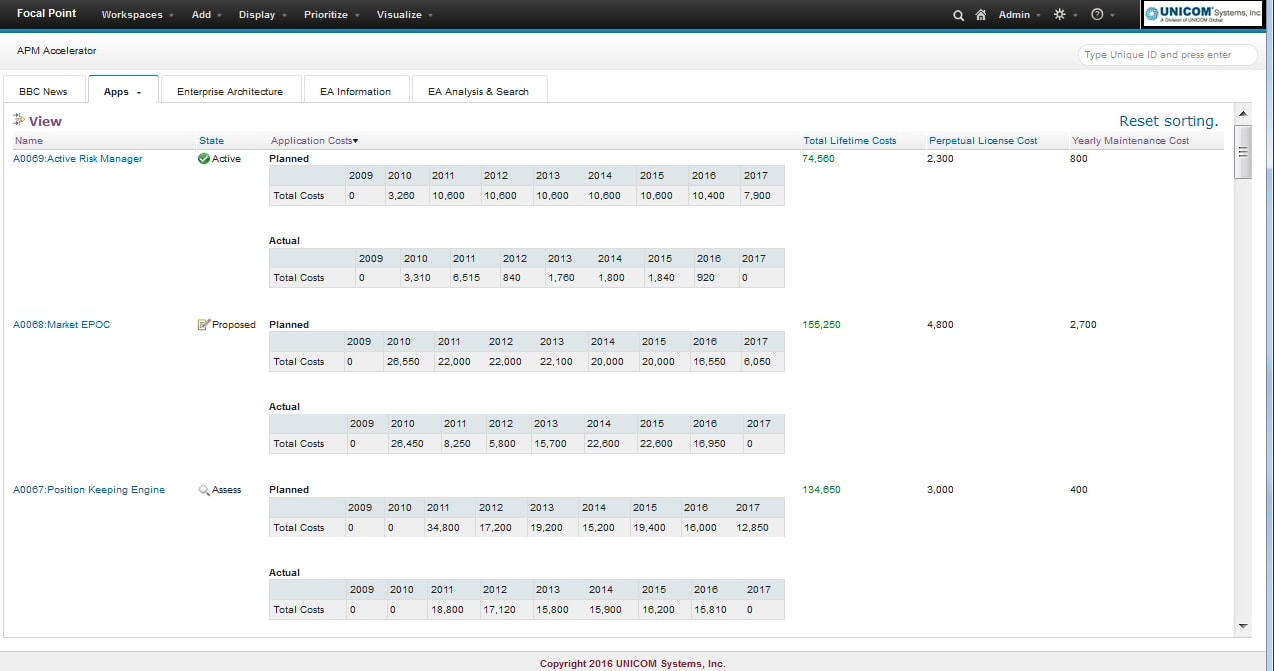 Planned and Actual Application Costs in a Time Grid
Planned and Actual Application Costs in a Time GridPipeline Prioritization
UNICOM® Focal Point™ provides four kinds of techniques to build priority lists:
- Pairwise comparisions -- great when there is no known quantitiative data; very early on, when you are trying to get a measure of value, stakeholders can do side-by-side comparisons of initiatives using a structured process to walk through a set of comparisons to build a statistically significant result
- Configurable Scorecards -- you can use these Comparitive Results to rate and rank a set of inititiatives to assure they are properly aligned to your strategic objectives.
- Known Quantitative Data from the Business Case -- information about the costs and benefits, capital and operational expenditures, benefits you are projecting, financial risk projections
- Visualization (trade-off analysis) -- you can confirm the rating and ranking process by visually displaying a set of initiatives against a selected set of variable criteria taking into account costs and benefits to the corporation. "What-If" scenarios allow the ability to change criteria weighting factors to envision different results and decisions as to value and benefits. The scenarios are limitless and can be stored for future comparisons against answers and directions taken.
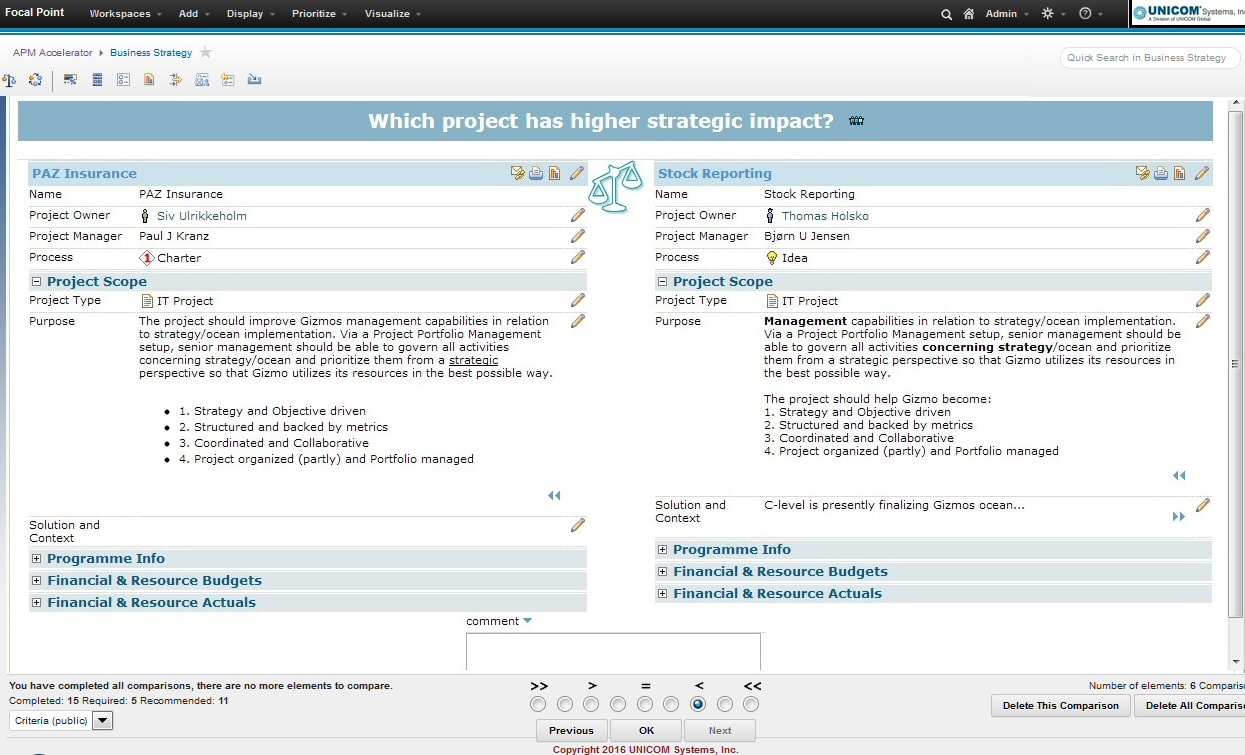 Pairwise-comparison sessions are a great way to get your customer base or management teams involved in the hard trade-off decisions that need to be made.
Pairwise-comparison sessions are a great way to get your customer base or management teams involved in the hard trade-off decisions that need to be made.
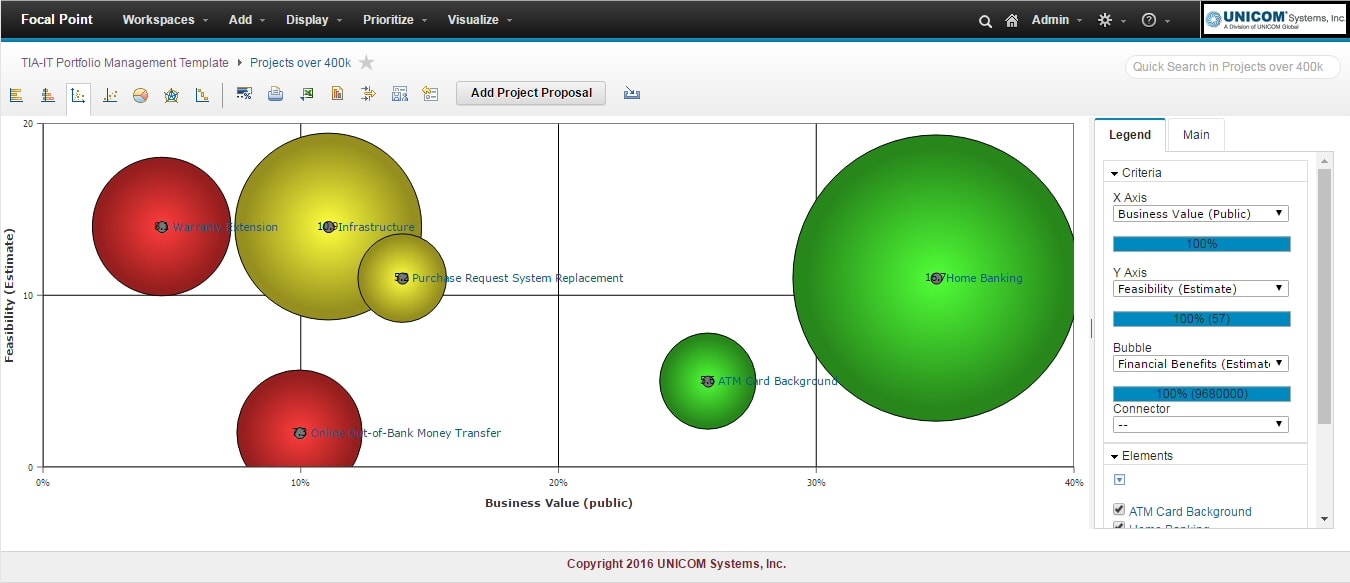 Bubble chart shows projects ranked by Feasibility, Business Value - and the size of the bubble in this case equaling Financial Benefits.
Bubble chart shows projects ranked by Feasibility, Business Value - and the size of the bubble in this case equaling Financial Benefits.
Delivery Planning
Plan for delivery based on the constraints of people, money, and time.
- Define the scope for a particular initiative, and model the capacity of resourcing that is required to deliver that initiative.
- Graphically build a roadmap for change, and shift it around based on constraints.
- Use Focal Point's workflow capabilities to move prioritorized projects to the next stage in the lifecycle
- Specify distinct business needs that the project is providing. This allows you to visualize recognizable capabilities for the business, so that if you run into delivery problems, you can still deliver a reduced set of capabilities to the business rather than holding the project to ransom based on a couple of glitches.
- Build a model of supply constraints and resources -- how many developers do you have? You can then schedule the initiatives based on the resources available at different time periods.
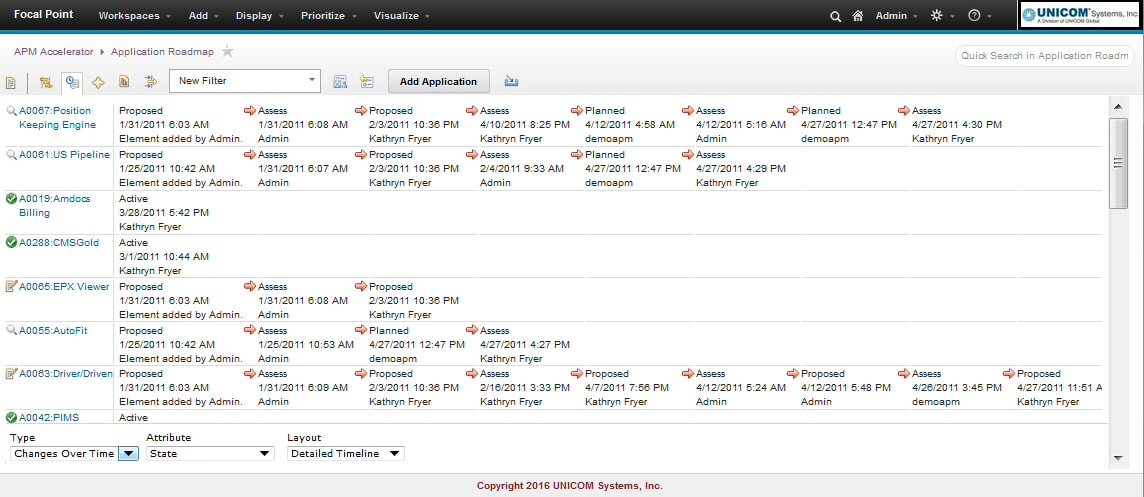 Detailed Application Roadmap
Detailed Application RoadmapWatch Focal Point in Action for IT Portfolio Management
Contact FocalPoint.Sales@unicomsi.com and request a demonstration.
Application Portfolio Management
Businesses face many challenges managing their application portfolio:
- In many organizations, a large percentage of IT funds are spent maintaining and operating a growing application portfolio that is becoming increasingly stale. Analysts estimate that 70-80% of IT operating budgets are being used to maintain existing applications. This means less money to spend on new strategic applications that can differentiate your organization in the marketplace.
- The complexity of a mature application portfolio that's been built up over many years leads to reduced business agility, since it takes too long for updates to these applications to yield an effective response to emerging business needs.
- As application portfolios propagate through mergers and acquisitions, a disconnect can form between business strategy and all of the processes and applications supporting it.
- An aging portfolio exposes the company to many risks, including compliance risk, risk of losing people with critical application knowledge, and risk associated with using old technology.
Continuously Assess Applications with APM
Application Portfolio Management (APM) is the practice of assessing the applications that run your business in terms of their business value, enhancement potential, cost, and risk. However, in most organizations, information about the application inventory, the associated technology, financial performance, business value, technical debt, and service quality is contained in a myriad of spreadsheets and systems, in people’s heads and distributed across isolated organizations. This prevents meaningful comparison and analysis of this information to enable timely decision making.
UNICOM® Focal Point™ provides a web-based, repository-driven APM solution that addresses these challenges -- enabling you to continuously assess applications through transparent and objective processes, helping teams make better and faster decisions by using information-gathering and analytics capabilities.
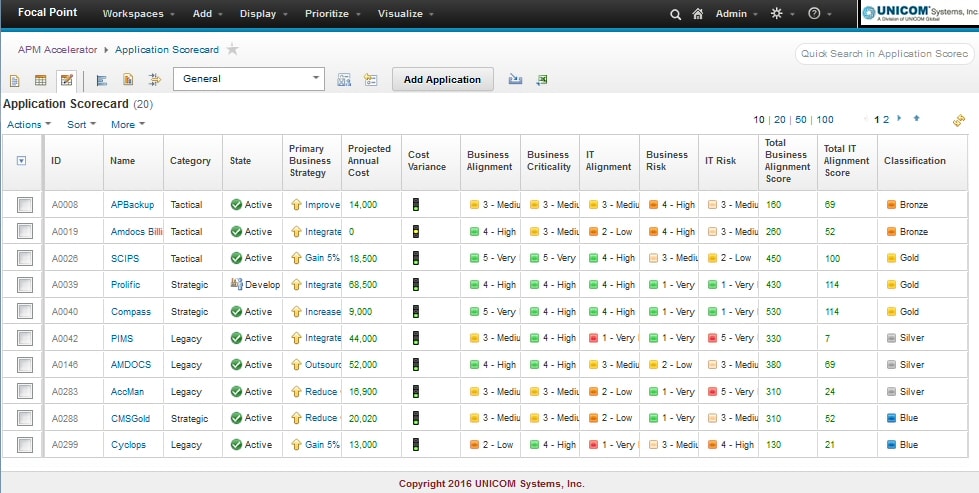 Application Scorecard
Application ScorecardUNICOM® Focal Point™ enables APM in a variety of usage scenarios:
- Consolidation -- Many organizations start with a consolidation and simplification of their application portfolio, since this approach can provide a fast payback time while allowing savings to be reinvested in further optimizations of the portfolio.
- Modernization -- Most companies have huge mission-critical investments in existing applications and often find it difficult to capitalize on those investments because they do not know how to prioritize the modernization efforts. WIth Focal Point, you can prioritize your legacy assets to highlight those that could yield maximum returns with an enterprise modernization program. These capabilities enable companies to reduce hardware, licensing fees, maintenance costs, improve business agility, open up new business opportunities and reduce risk associated with aging skills and technology.
- Investment management -- Objectively and transparently align funds spent on application maintenance and renovation with organizational priorities.
- SLA optimization -- consolidate the number of service level agreements (SLAs) you use to simplify operations. While avoiding the assignment of high SLA levels to non-business-critical applications to reduce operational costs.
- Compliance -- Once an application inventory has been established, it is much easier to extend its use to manage regulatory and industry compliance.
- Cloud -- Decide what applications should be moved to the cloud by looking at factors such as seasonal fluctuations in load and technology alignment with the cloud operating environment. Understand which applications can be lift-and-shifted to the cloud, versus redesigned or recreated as cloud native based on application code assessments.
Focal Point for APM
UNICOM® Focal Point™ APM features include:
- A robust, web-enabled solution for maintaining an application inventory, with rigorous security and change tracking capabilities.
- Web-survey and role-based views helping stakeholders provide the application information that the system prompts them to collect.
- Ability to automatically collect information from other information sources (using Microsoft Excel, CVS file format, SOAP and web-services interfaces).
- Workflows supporting the application gathering, assessment, and decision making process.
- Analytics supporting score carding for rapid and objective decision making.
- Collaborative decision support helping a team set priorities and evaluate options based on agreed-to priorities.
- Support for project identification and definition, project road mapping based on resource and financial constraints and project selection based on desired selection criteria.
- Financial analysis, including ability to do what-if assessments for estimating return on investment (ROI) reflecting the inherent uncertainty in cost and benefit analysis of future transformation projects.
- Using the on-board Monte Carlo Simulator financial probability calculations can return "what-if" scenarios for "Low", "Likely" and "High" values over time, including the cost of money.
- Returns can be in the form of: NPV Standard Deviation, NPV Distribution, NPV Mean, ROI, ROI to Date, ROI to Go, IRR, Payback Period and Payback Period Distribution.
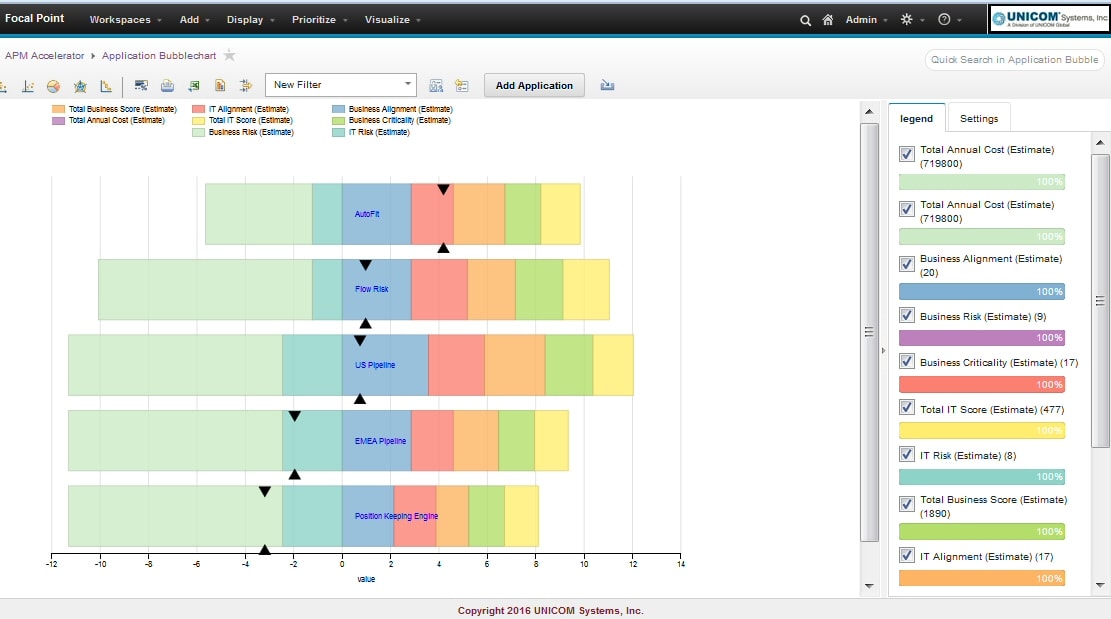 Stacked Bar Chart automatically ranks and stacks Applications top to bottom based based on totaling of positive (right of y axis) and negative (left of y axis) variables
Stacked Bar Chart automatically ranks and stacks Applications top to bottom based based on totaling of positive (right of y axis) and negative (left of y axis) variables
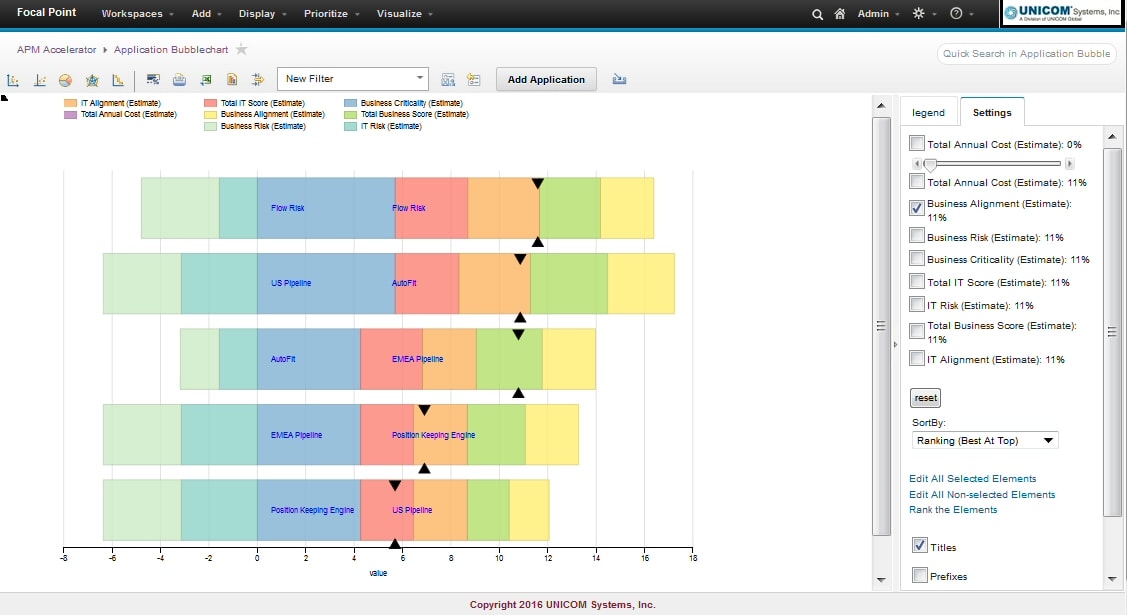 Perform What-If Analysis -- swizzle the the variables in the right-hand pane to change the effects of positive and negative variables on each Application, possibly changing the stacked ordering.
Perform What-If Analysis -- swizzle the the variables in the right-hand pane to change the effects of positive and negative variables on each Application, possibly changing the stacked ordering.
APM Enhanced by Enterprise Architecture
You can compare the APM analysis results to the application inventory in System Architect using the Focal "Point-System Architect" integration, visualize the APM results as analytics on the architecture, and do cause-effect analysis on the business. Create roadmaps for change. Assess the technical and business impact of application change.
APM Feeding Project Portfolio Management
APM feeds the project portfolio management process -- create project proposals for taking action to address the cost of management and maintenance of applications. Actions can range from modernizing or discontinuing applications to new development.
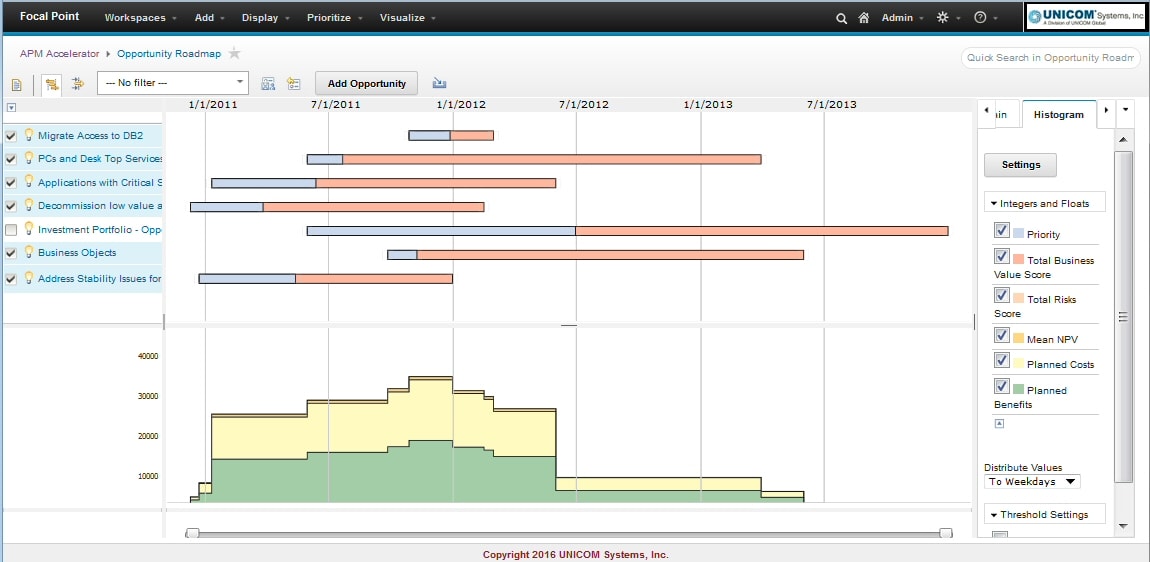 Roadmap of Applications plotted against time over histogram of resources available.
Roadmap of Applications plotted against time over histogram of resources available.Watch Focal Point in Action for APM
Contact FocalPoint.Sales@unicomsi.com and request a demonstration.
Demand & Delivery Management
Demand Management
Your IT department receives continuous demands for services and solutions. Demands can range from minor enhancements to corporate applications, to major transformational initiatives based on business events, to ideas that take advantage of disruptive technologies and leap your organization ahead of the competition. It is up to the IT department to manage these demands -- prioritorize and implement them -- as well as make and defend prioritization decisions so that the wrong demands don't get attention due to executive pressure or a "squeeky wheel".
At the same time, demands are constantly changing, and some demands are very similar to but not quite exactly like others. Furthermore, demands need to be traced through to execution -- with a developed solution often satisifying some but not all of the demand.
UNICOM® Focal Point™ is designed for ideas capture and demand management in this complex environment. It enables you to:
- Capture new investment ideas and demands from a large community of stakeholders in a central, repository-based solution with a web interface that everyone in the organization can access.
- Manage the continuous stream of ideas, opportunities, and business demands in dashboards -- enabling you to identify duplications and conflicts.
- Prioritize business needs, ideas, and project proposals in a variety of ways, such as pairwise comparision and strategic ranking, to promote and defend strategic decisions.
- Use workflows to support an executive decision and sign-off process for demands.
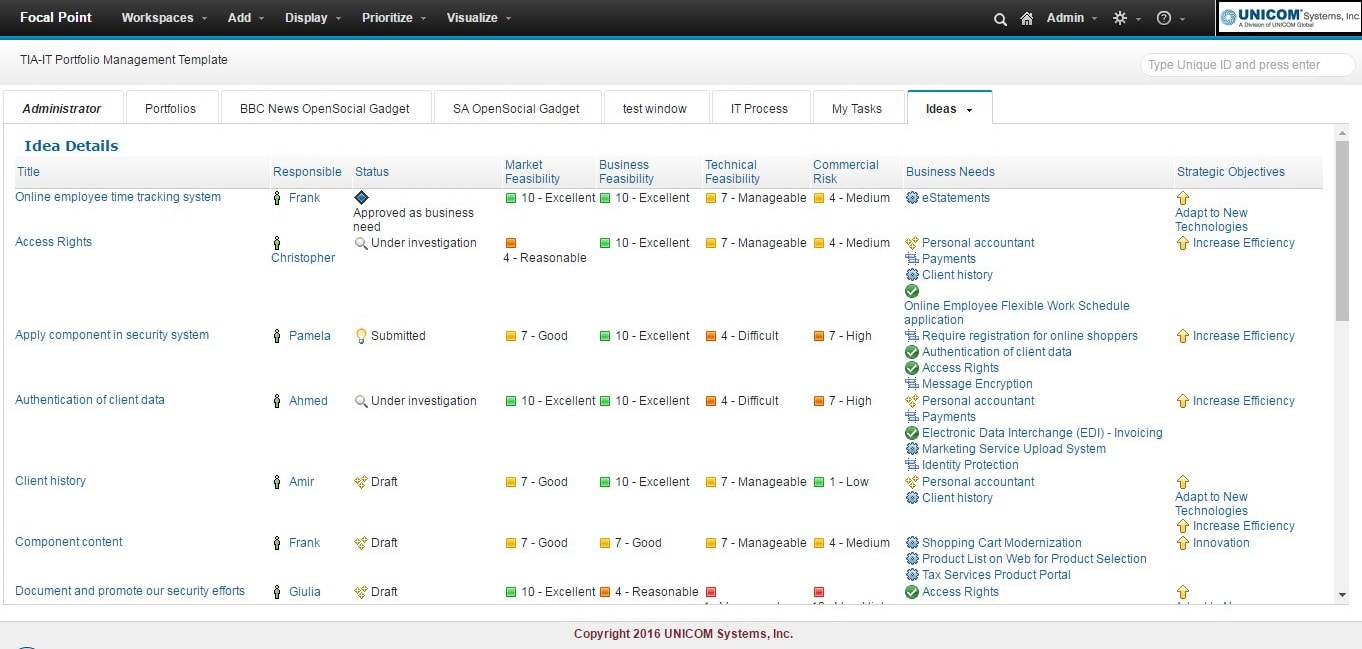 Capture Ideas from Customers or Employees in UNICOM® Focal Point™'s Web Portal
Capture Ideas from Customers or Employees in UNICOM® Focal Point™'s Web PortalDelivery Management
Once new solutions or systems have been approved, they need to be fielded. This can be a complex on-going task. In most organizations, product teams are globally distributed and are developing products using their own methods and practices. You need to be sure that they are delivering the right product capabilities at the right time with the greatest efficiency. Development teams need to collaborate closely with stakeholders to ensure that they are developing the right thing, and collaborate with each other to share practices and standards. Management needs visiblity into what is going on so it can help the technical teams with resources, and manage road maps to operate within financial and resource constraints. Business and product managers need visibility into the delivery pipeline so that they can understand how things are going.
In the meantime, business requirements for what your customers or internal stakeholders want are constantly changing, as are internal factors like development resources. You need to be able to respond to changing portfolio demands by knowing exactly where you are and how you can adjust because that is going to determine how successful you are.
UNICOM® Focal Point™ is designed for delivery management in this complex environment. It enables you to:
- Guide efficiencies and control through collaboration, communication, and transparency about delivery pipeline information
- Create teams that can self-direct themselves using standard processes and governed standards, enabling agility on a wider scale with increased transparency and governance
- Understand value and estimate the cost of tradeoffs so you can manage projects and operate within resource, financial, and time constraints
- Respond quickly to business and project changes to ensure that risk is mitigated early and priorities are adjusted appropriately
- Inform decision-makers at all levels with improved traceability
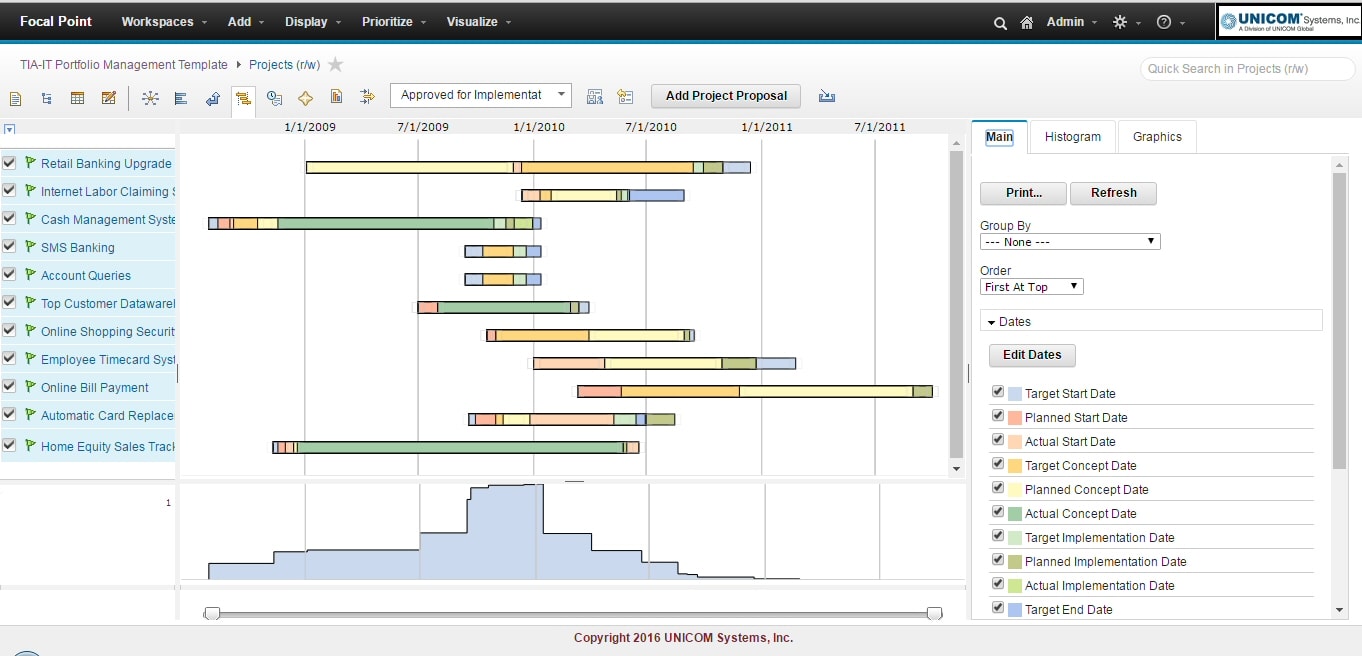 Roadmap of Projects plotted against time over histogram of resources available.
Roadmap of Projects plotted against time over histogram of resources available.Integration with Other Tools in the DevOps Delivery Lifecycle
Demand and delivery management with UNICOM® Focal Point™ enables you to scale the DevOps process, and use methods such as the Scaled Agile Framework (SAFe) to meet today's complex velocity challenge -- going faster, helping teams to deliver changes to the business as quickly as possible, so you can get their feedback and make sure what you're delivering has the most business value. UNICOM® Focal Point™ utilizes Open Service for Lifecycle Collaboration (OSLC) standards to integrate seamlessly with other tools in the DevOps chain -- from requirements, to solution design, to build, test, and deployment.
You can see information in other 'friend' tools across the network -- such as requirements, change requests, action items, solution designs, tests, and application components to be deployed -- create links to relevant artifacts in those tools, then see and navigate those links at any time. OSLC creates a federated picture of corporate information to help you manage the DevOps processes of release management, testing, and deployment. Focal Point becomes the fulcrum for planning, executing, and delivering solutions.
Watch Focal Point in Action for Demand & Delivery
Contact FocalPoint.Sales@unicomsi.com and request a demonstration.
System Requirements
Project Portfolio Management
Determine the Optimal Projects
How does your organization manage its on-going and planned project portfolio? How do you make sure that projects are aligned with company objectives and strategies? What is in the project portfolio? Does the portfolio include the projects that bring the most value to your company? Do the projects align with customer and internal-stakeholder requests and market demand? How well are your projects performing? What risks do you face? Have you chosen the best and most important projects to the business?
With UNICOM® Focal Point™ you can gain a 20,000-foot view of on-going and planned projects in the organization. Therefore, gaining visibility into each project's total expected cost, consumption of resources, expected timeline, benefits to be realized, and interdependencies with other projects in the portfolio. This allows an optimim mix of projects to be selected and approved while aligning them with business priorities.
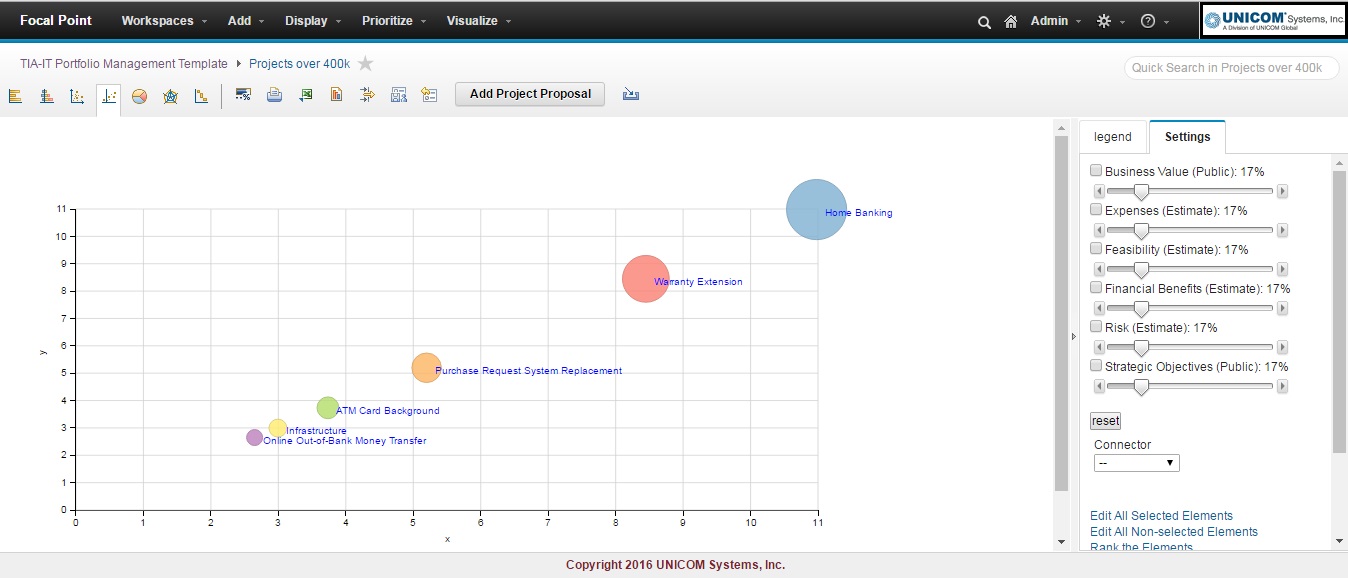 Bubble chart shows all Projects over $400k, ranked by Feasibility, Business Value - and the size of the bubble in this case equaling Expenses.
Bubble chart shows all Projects over $400k, ranked by Feasibility, Business Value - and the size of the bubble in this case equaling Expenses.Web-Based Team Contributions
UNICOM® Focal Point™ is a web-based solution with an underlying database repository, enabling people across your organization to enter and access project information based their role. Project templates can be customized to be specific to each organization or department. It can be integrated with and import data from other applications or solutions for project management and the PMO. Configurable workflows enable teams to submit project proposals, provide information to the project, and send it through reviews and an approval based on your business process. Projects can be aligned to business objectives, strategies, capabilities, demands, services, applications, technologies, and other aspects of the business.
Trade-Off Analysis
UNICOM® Focal Point™ enables you to perform trade-off analysis of projects by using best-in-industry approaches such as pair-wise comparison, stacked bar charts with ranking schemes, and bubble charts. You can automatially determine net benefits of projects using adjustable weighting for different positive and negative criteria. You adjust the weighting of positive and negative criteria to do 'what-if' scenario analysis. This process provides understanding of the value of projects while estimating the cost of tradeoffs so that projects are set up for success and operate within resource, financial, and time constraints.
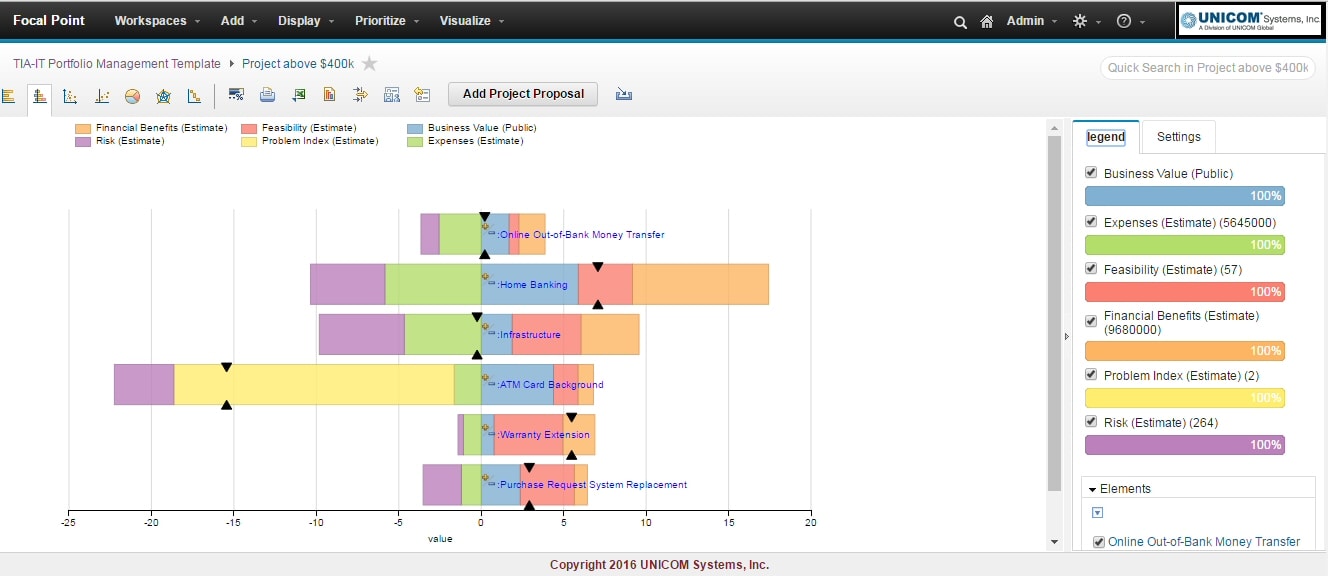 Stacked bar chart showing Projects automatically stacked (ranked) from highest priority to lowest priority based on totaling of positive (right of y axis) and negative (left of y axis) variables.
Stacked bar chart showing Projects automatically stacked (ranked) from highest priority to lowest priority based on totaling of positive (right of y axis) and negative (left of y axis) variables.Perform Resource Management
UNICOM® Focal Point™ enables you to specify and track resources assigned to projects. You can then view groups of projects in a timeline mashed against a resource-utilization historgram to red flag over-utilization issues that will cause bottlenecks. This allows you to perform more effective resource allocation, so that you can align development decisions with your overall business strategy.
 Roadmap of Projects plotted against time over histogram of resources available.
Roadmap of Projects plotted against time over histogram of resources available.Benefits
UNICOM® Focal Point™ enables you to:
- Centralize project information key to decision making, status reporting, and reviews. This collaborative platform helps reduce the chaos of managing project portfolio information using emails, documents, spreadsheets, and isolated project tools.
- Determine a project's Net Present Value (NPV) and understand the impact of risk and uncertainty surrounding these values.
- Prioritorize projects and groups of projects using qualitative and quantitative analysis and key performance indicators (KPI's).
- Automatically determine net benefits of projects, using adjustable weighting for different positive and negative criteria.
- Perform trade-off analysis of projects using best-in-industry approaches such as pair-wise comparison, stacked bar charts with ranking schemes, and bubble charts.
- Perform what-if analysis using adjustable ranking schemes for stacked bar charts.
- Show resource utlization of a set of projects across a timeline.
- Determine bottlenecks due to over utilization of resources. Perform more effective resource allocation, so you can align development decisions with your overall business strategy.
- Determine the interaction and effect of a project sequence on revenue, costs and resources. Now you can quickly align and adjust road maps as business and marketplace needs change.
- Focus on managing value and change to create true business value.
Watch Focal Point in Action for Project Portfolio Management
Contact FocalPoint.Sales@unicomsi.com and request a demonstration.
Evaluate
Hands-On Evaluation
To evaluate UNICOM® Focal Point™, please send an email to FocalPoint.Sales@unicomsi.com. In the subject field ask for an Evaluation Request for Focal Point. Sales will ask you for specific information to qualify you for the evaluation.
Request for Information
If you would like to submit a Request for Information for a Portfolio Management tool, please send an email to FocalPoint.Sales@unicomsi.com.
Watch the Product In Action
Contact FocalPoint.Sales@unicomsi.com and request a demonstration.
Product Management
UNICOM® Focal Point™ is a leading tool for pure Product Management -- enabling Product Managers to make decisions on what features to put into a product, what new products to build, and to develop product roadmaps based on customer priorities, competitor functionality, and market conditions. Focal Point's pure web-based capability and underlying database repository allow you to engage directly with customers. It allows them to vote on product enhancements using pairwise comparisons -- from which they emerge as part of the process and they understand how difficult the "trade-off" analysis of new features is and how easily Focal Point manages it.
Prioritorize Enhancements
UNICOM® Focal Point™ enables you to:
- Get up and running quickly using Focal Point's out-of-box Product Management template based on industry best practices.
- Prioritize and visualize customer needs to make better decisions about which requirements to implement.
- Build and manage a vision for your product.
- Prioritorize enhancements using "trade-off" analysis with best-in-industry approaches such as pair-wise comparison and stacked bar charts with ranking schemes
- Allow your customers to be part of the enhancement prioritorization process, providing them web access to pairwise comparison of your enhancement list.
- Manage priorities and schedule enhancements with the Development Team using product roadmaps.
- Manage the cycle of continuous feedback, iteration, re-prioritization, and new releases.
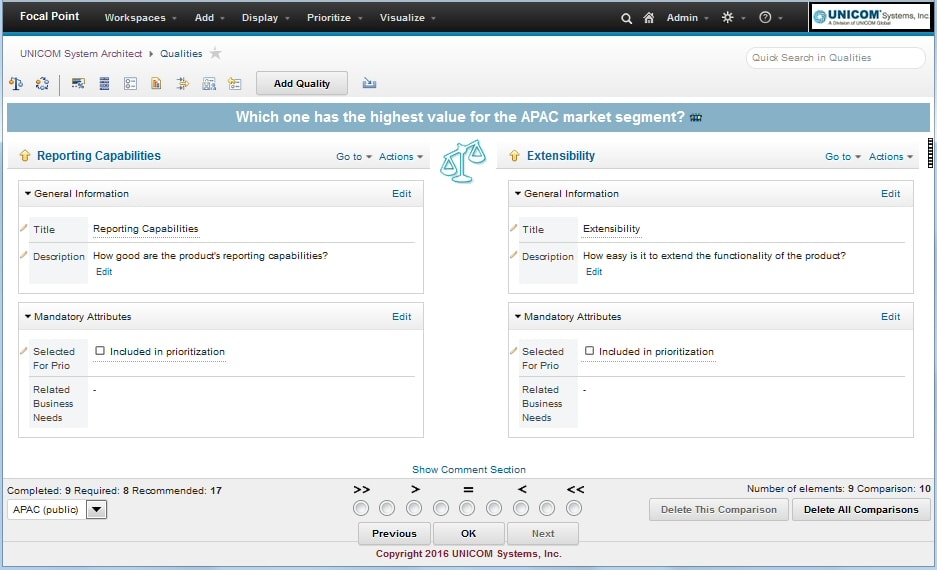 Pairwise-comparison sessions are a great way to get your customer base involved in the product enhancement trade-off decisions that need to be made.
Pairwise-comparison sessions are a great way to get your customer base involved in the product enhancement trade-off decisions that need to be made.Develop New Products
Use UNICOM® Focal Point™ to:
- Collaborate with customers and subject matter experts (SME's) in the field to rapidly develop a Product Concept.
- Develop a business case.
- Define features for the new product.
- Pick the right feature combination for the new product.
- Set pricing and project roadmap for design, testing, and delivery.
- Reduce risks using cost estimation models.
- Plan the right product with the right features to be developed at the right time and the right cost.
Develop Roadmaps
Use UNICOM® Focal Point™ to:
- Work with Development, Documentation, Testing, Marketing, Sales, and Operations to establish milestones and delivery dates of each release.
- Plan releases over time to improve the speed and quality of delivery.
- Visualize product roadmaps for enhanced communication amongst team members in your organization as well as customers.
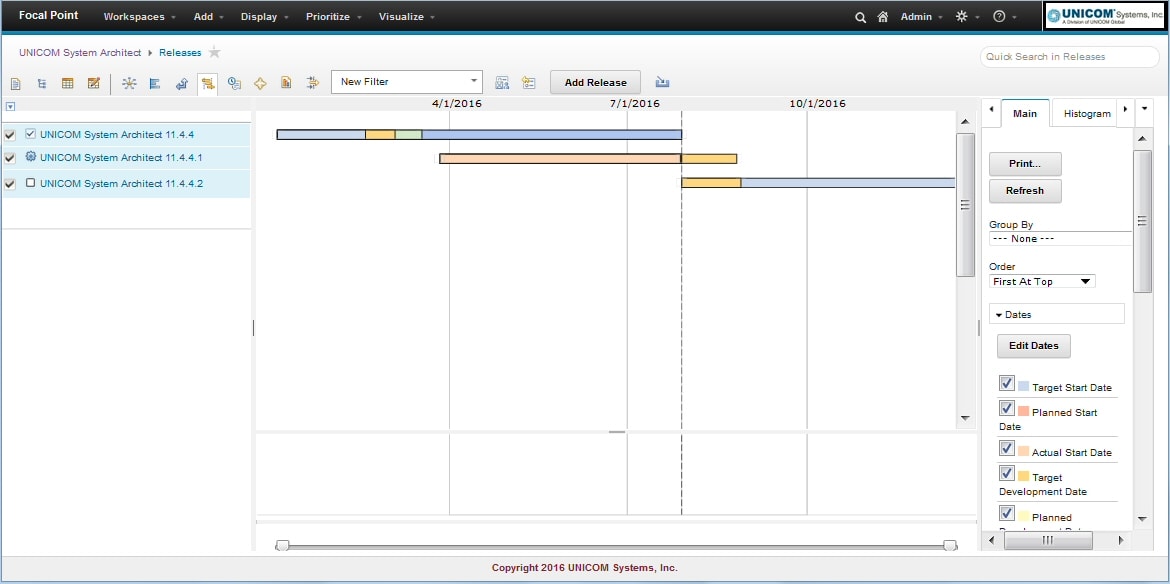 Use the Product Management template to quickly get up and running building roadmaps for your product.
Use the Product Management template to quickly get up and running building roadmaps for your product.Perform Product Portfolio Analysis
You can analyze the value of all the products in your portfolio, to make decisions on which products to increase investment in, which products to maintain, and which products to divest or sunset.
- Align products with the strategic direction of organization.
- Make investment decisions with a transparent view of costs and market opportunity.
- Make kill/sunset decisions.
- Understand non-cost 'fuzzy' factors that make a product strategic.
- Make trade-offs, based on the changing priorities of the marketplace and your organization.
- Deliver investment visibility by monitoring market needs vs your total portfolio.
- Implement a decision-making process that is visible and transparent.
- Use objective information to support quick and accurate decision making.
- Use intelligent dashboards such as stacked bar charts and bubble charts to aid the decision-making process based on strategic objectives and KPI criteria measurements.
- Pick the right Products to invest in and divest/sunset.
- Continuously monitor the portfolio.
- Optimize the overall product revenue, value to the customer, and cost of development.
Capabilities
Harvest Information
Harvest applications, technologies, standards, systems and data from a variety of sources of record:
- REpresentational State Transfer(REST) Integration
- Open Service for Lifecycle Collaboration (OSLC) Integration
- Excel import/export
- Web-based portal for form-based input from internal employees and/or external customers
- Email import
Analysis Techniques
- Pairwise comparison -- Focal Point automatically selects the best pair of elements to compare based on internal algorithms; the end user can rank how much they prefer one choice over the other.
- Investment Analysis
- Financial Planning Using Time Grid Attribute
Dashboard Charts
- Roadmaps and Gantt charts—frequently used in project management as illustration of a project schedule that is used to plan, coordinate, and track specific tasks in a project against time. Also used for plotting other organizational resources against a timeline—applications (starting with their field date to their retirement date), technology, etc.
- Gantt Chart Histogram -- additional insight to an issue can be formed by laying a histogram of resources, costs, etc. underneath and along a timeline of a roadmap tracking a project, application, and so forth
- Roadmap Dependency Lines
- Bubble Chart (also known as XY chart)
- Stacked XY charts
- Bar chart -- a bar chart displays the priorities for a selected view and criterion
- Stacked bar chart
- Ranking schemes—In stacked bar charts, the total score for each element is displayed. There are two options to calculate the total score: a) Positive - Negative, wherein the score is calculated as the sum of the priorities of the Maximize criteria minus the sum of the priorities of the Minimize criteria, and b) Positive / Negative, wherein the score is calculated as the sum of the priorities of the Maximize criteria divided by the sum of the priorities of the Minimize criteria.
- Stacked bar chart
- Pie chart
- Radar chart
- Waterfall chart
Respository
Focal Point stores data in a central repository that is a database on your choice of PostGresSQL, Oracle, or DB2.
Customizable Metamodel
You can customize the metamodel of information captured to add object types, property sets, relationships, and possible values.
Integrations via OSLC and REST
Focal Point embraces and supports both Open Service for Lifecycle Collaboration (OSLC) and REpresentational State Transfer (REST) standards. You can create traceability links between the portfolio and related requirements, change requests, action items, or solution designs in architecture, change management, or requirements tools. A simple right-mouse click enables you to see information in other 'friend' tools across the network and create links to relevant artifacts in them, then see and navigate those links at any time. With OSLC or REST one can create a federated picture of corporate information and helps make Portfolio Management more insightful. Use this traceability to govern delivery management, and align to the DevOps processes of release management, testing, and deployment.
Resources & Support
Support
If you are an existing customer, please join or log into the UNICOM Customer Support Portal for Focal Point, where you will find latest help, tech support incidents, and detailed information about the product.
Data Sheets
Social Media
Request for Information
If you would like to submit a Request for Information for a Portfolio Management tool, please send an email to FocalPoint.Sales@unicomsi.com.
Case Studies
Chubb Insurance
Following a relocation of its European holding company from Brussels to London, Chubb Insurance came under the oversight of the UK Financial Services Authority – creating new, more complex requirements for risk management across the whole European organization.
Chubb’s Risk Management Office developed a web-based solution built on UNICOM Focal Point software. Users across Europe can collaborate in monitoring, assessing and managing risks and controls, while senior managers can gain a real-time overview of risk status.
Laminar Medica
In an increasingly competitive marketplace, Laminar Medica wanted to improve its insight into the competition to support future business growth.
The company used UNICOM Focal Point software to create a companywide resource for competitive intelligence that supports market-driven product development and more-informed portfolio decisions.
Training & Services
Training
UNICOM offers the following training classes for UNICOM® Focal Point™; contact FocalPoint.Sales@unicomsi.com for detail and dates:
Using Focal Point
1-day hands-on course
Intended Audience:
- Primary target audience:
- Product managers
- Define and edit data in UNICOM Focal Point
- Display data in static and dynamic views
- Find information in UNICOM Focal Point based on sorts and filters
- Seconday target audience
- Program or project managers
- Implementation team leads
- Implementation teams
After completing this course, you will be able to:
- Describe the structure of data in UNICOM Focal Point
- Work with information in UNICOM Focal Point
- Define and edit data in UNICOM Focal Point
- Display data in static and dynamic views
- Find information in UNICOM Focal Point based on sorts and filters
- Create relationships between elements
- Use review checkpoints for various data integrity activities
- Prioritize elements using actual data and pair-wise comparisons
- Use estimated and relative criteria to support decision making
Course Outline
- Module 0: About This Course
- Module 1: Introduction to UNICOM Focal Point
- Module 2: Information Structure and Interface Basics
- Module 3: Adding, Displaying, and Editing Data
- Module 4: Review Feature
- Module 5: Prioritization and Visualization
- Module 6: Summary
Configuring Focal Point
1-day hands-on course
Intended Audience:
- Primary target audience:
- Tool administrators and advanced users
- Product managers and portfolio managers
- Seconday target audience
- Program or project managers
- Development team leads
This is a one day course that introduces you to the UNICOM Focal Point product from the perspective of an administrator or advanced user.
- Support various processes: create customized information structures and workflows
- Create roles to control user access
This course assumes that you have a knowledge of course:
- "Using UNICOM Focal Point"
After completing this course, you will be able to:
- Describe the structure of UNICOM Focal Point
- Configure UNICOM Focal Point at a basic level
- Create a brandnew workspace
Course Outline
- Module 0: About This Course
- Module 1: UNICOM Focal Point Information Structure
- Module 2: Setup and Administration
- Module 3: Configuring Workspaces, Modules, and Attributes
- Module 4: View and Access Control
Services
UNICOM offers services for UNICOM® Focal Point™ and portfolio management through a network of highly-skilled UNICOM consultants and business partners; contact FocalPoint.Sales@unicomsi.com for more information.
EA & Portfolio Management
Assessment of your application and technology portfolio is best performed when you integrate portfolio analysis with enterprise architecture -- allowing you to understand the impact of changes before making decisions. Then you can build transition plans and manage your project portfolio to bring the organization to new, more efficient levels.
UNICOM Focal Point™ enables you to do a thorough analysis of your Information Technology (IT) portfolio against non-architectural data points such as costs, development bandwidth, or survey results. The System Architect®-Focal Point™ integration enables you to take those results and bank them off of the enterprise architecture, so you can do visual analytics on the architecture, and quickly understand how changes to the IT landscape will affect business owners, processes, services, and capabilities.
Application Portfolio Management
Rapidly create an application inventory in either System Architect or Focal Point. Map applications to Focal Point and run pre-provided reports to analyze and assess applications based on business and IT value, improvement potential, and risk. Score applications against defined, prioritized, and weighted business and technical criteria. Determine what applications should be moved to the cloud, rearchitected for the cloud or mobile, retired, sustained, enhanced, consolidated, or replaced. Determine what applications should be developed as new mobile, cloud-aware, or cloud-native apps and what apps should be purchased.
 Stacked Bar Chart automatically ranks and stacks Applications top to bottom based based on totaling of positive (right of y axis) and negative (left of y axis) variables
Stacked Bar Chart automatically ranks and stacks Applications top to bottom based based on totaling of positive (right of y axis) and negative (left of y axis) variablesThen bank the analysis results off of the application inventory in System Architect using the Focal Point-System Architect integration, visualize the APM results as analytics on the architecture, and do cause-effect analysis on the business. Create roadmaps for change. Assess the technical and business impact of application change. Select and plan portfolio transformation initiatives, such as projects for decommissioning or modernizing applications.
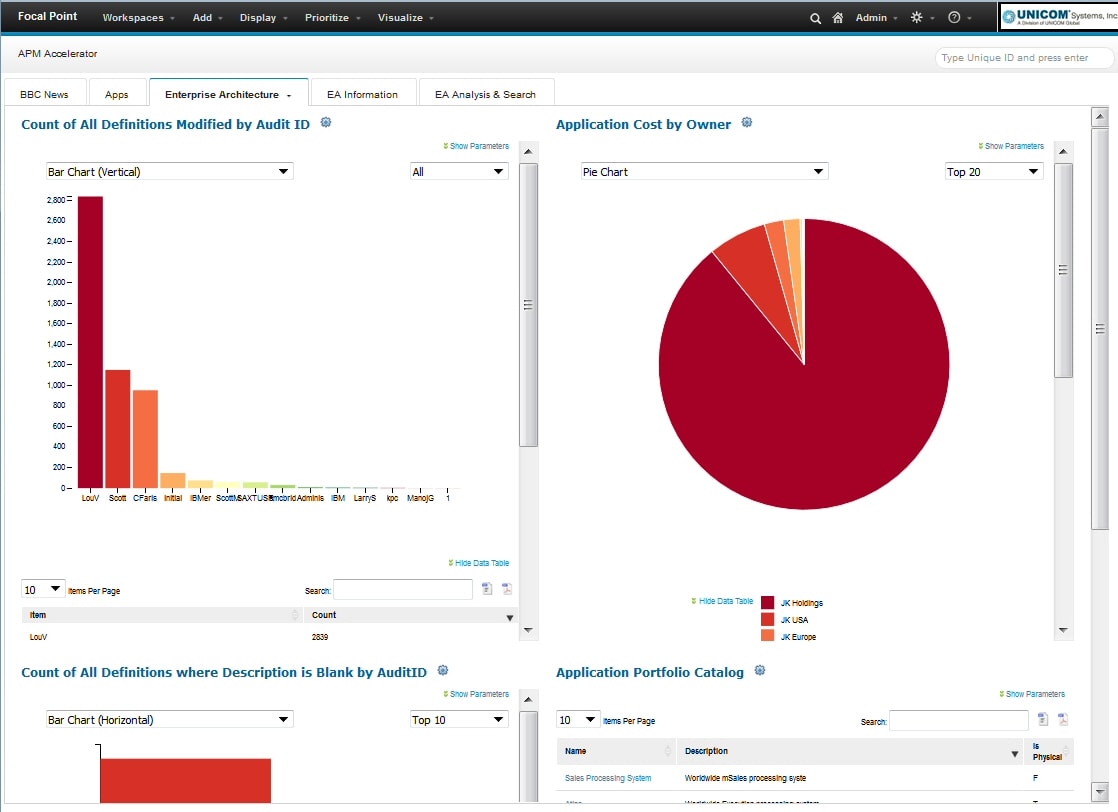 Enterprise Architecture reports from UNICOM® System Architect® surfaced in a mashup of information in UNICOM® Focal Point™.
Enterprise Architecture reports from UNICOM® System Architect® surfaced in a mashup of information in UNICOM® Focal Point™.Technology Portfolio Management
Understand how changes to your application portfolio impact your technology portfolio -- and vice versa. Use the enterprise architecture to assess what technologies are being used in applications and systems across the organization, where they are being used, and what effects technology risks have on the business.
Identify technology innovations that can provide new capabilities for the business. In Focal Point, assess new technologies and do trade-off analysis of their features, benefits, costs and market acceptance. Back in System Architect, use the EA to help implement governance of chosen technology standards. Then build roadmaps of new technologies, their projected costs, and the capabilities they will provide.
Project Portfolio Management
Use enterprise architecture to move project portfolio management out of its vacuum. Align projects and sub-projects to the capabilities they enable, the business strategies they support, and the IT portfolio they change. Map the projects to Focal Point, where your steering committe canprioritize projects based on predefined sets of criteria such as strategic fit, architectural fit, business risk, budget constraints, manpower constraints, targeted portfolio reductions, cost savings, or your own attribute set. Identify which projects are higher priority based on the needs of the business, and determine the best project portfolio mix given the constraints of manpower and costs.
Map the analysis from Focal Point back to the enterprise architecture, use analytics to visualize the project portfolio analysis, and assess the cause-effect of prioritorized projects on the enterprise. Armed with this information, you have a much higher degree of confidence for what transformation projects to pursue.
Products
System Architect
System Architect base product provides the following features:
- TOGAF
- Business Motivation Model (BMM)
- BPMN 2.0
- Logical and Physical Data Modeling
- Data Flow diagramming
- Capability Maps, Strategy Maps & Balanced Scorecards
- UML
- SOA design
- XML design
- Reporting System including dozens of pre-written reports
- Dashboard capabilities
- SA Compare
- Customizable metamodel
- Real-time multi-user capabilities
- Microsoft SQL Server Express for stand-alone work; users deploy full-blown Microsoft SQL Server to network for multi-user use.
Add-ons
- DoDAF 2, NAF 3, MODAF 1.2, DoDAF 1.5 ABM
- FEAF 2
- SA XT live web architecture capabilities
- SA Publisher architecture website generation capabilites
- SA Simulator to simulate and optimize process flows
- SA ERP to harvest ERP systems
Focal Point
Focal Point provides the following features:
- Application Portfolio Management
- IT Portfolio Management
- Product Delivery Management
- Project Portfolio Management
- Product Management
- Harvesting Techniques:
- Web-based portal for input by employees or customers
- Excel import/export
- Microsoft Word Import
- Email Import
- Analysis Techniques:
- Pairwise comparison
- Investment analysis
- Financial planning using Time Grid Attribute
- Dashboard Charts:
- Roadmaps and Gantt Charts
- Gantt Chart Histogram
- Bubble Chart
- Stacked XY or Bubble Charts
- Bar Chart
- Stacked Bar Chart
- Ranking schemes
- Stacked Bar Chart
- Pie Chart
- Radar Chart
- Waterfall Chart
- Roadmaps and Gantt Charts
SA-Focal Point Integration
Integration provides mapping-of-data capabilites between the tools.
- Map System Architect definitions and properties to Focal Point modules and attributes, respectively
- Map System Architect definitions and properties to Focal Point criteria and attributes, respectively
- Map Focal Point modules and attributes to System Architect definitions and properties, respectively
- Map Focal Point criteria and attributes to System Architect definitions and properties, respectively
SA-Focal Point OSLC Integration
Provides ability to link an artifact in System Architect to an artifact in Focal Point, via the OSLC CM specfiication.
Capabilities
SA-Focal Point Integration
Provides the following mapping-of-data capabilities between the tools:
- Map System Architect definitions and properties to Focal Point modules and attributes, respectively
- Map System Architect definitions and properties to Focal Point criteria and attributes, respectively
- Map Focal Point modules and attributes to System Architect definitions and properties, respectively
- Map Focal Point criteria and attributes to System Architect definitions and properties, respectively
- Both products have customizable metamodels -- so you can extend each to accomodate your architecture types and property types
- Mapping provided:
System Architect Focal Point Encyclopedia Workspace Encyclopedia Workspace Workspace Definition Module, Criteria Property Attribute Access Control Feature View
OSLC Integration
Provides ability to link an artifact in System Architect to an artifact in Focal Point, via the OSLC CM specfiication.
Resources
Technical Papers


 Mobile Data Protection Privacy Policy
Mobile Data Protection Privacy Policy